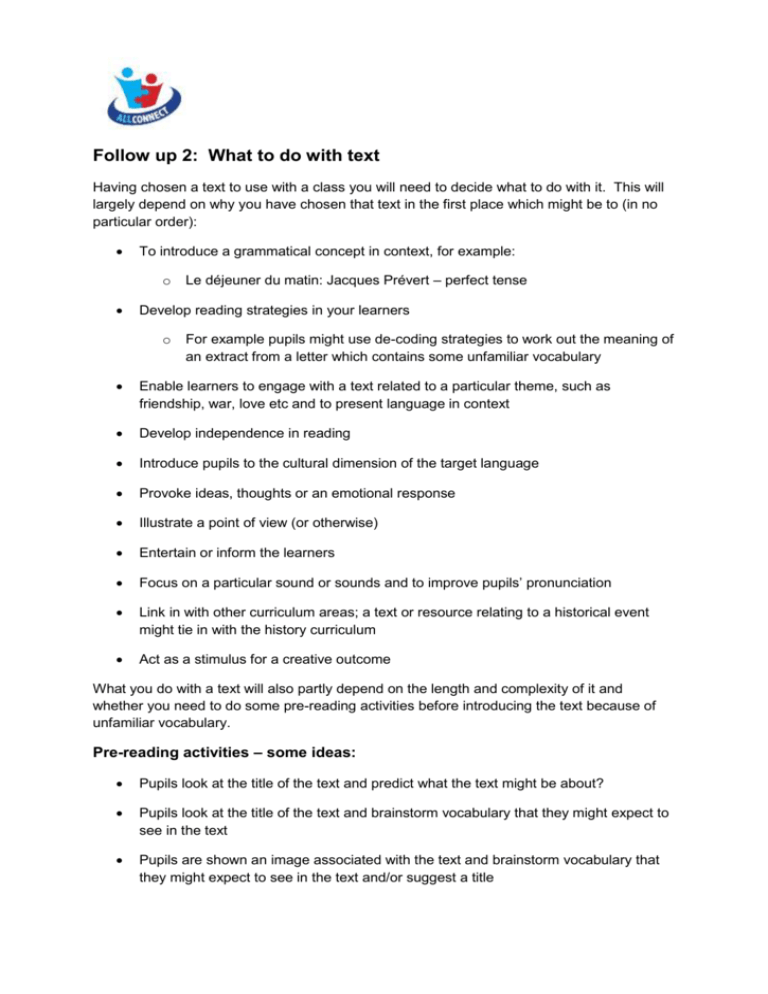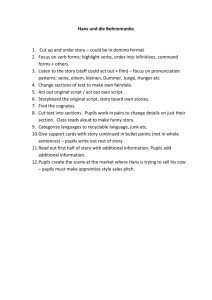KS3 Literature module Follow up 2.1 What to do with texts
advertisement

Follow up 2: What to do with text Having chosen a text to use with a class you will need to decide what to do with it. This will largely depend on why you have chosen that text in the first place which might be to (in no particular order): To introduce a grammatical concept in context, for example: o Le déjeuner du matin: Jacques Prévert – perfect tense Develop reading strategies in your learners o For example pupils might use de-coding strategies to work out the meaning of an extract from a letter which contains some unfamiliar vocabulary Enable learners to engage with a text related to a particular theme, such as friendship, war, love etc and to present language in context Develop independence in reading Introduce pupils to the cultural dimension of the target language Provoke ideas, thoughts or an emotional response Illustrate a point of view (or otherwise) Entertain or inform the learners Focus on a particular sound or sounds and to improve pupils’ pronunciation Link in with other curriculum areas; a text or resource relating to a historical event might tie in with the history curriculum Act as a stimulus for a creative outcome What you do with a text will also partly depend on the length and complexity of it and whether you need to do some pre-reading activities before introducing the text because of unfamiliar vocabulary. Pre-reading activities – some ideas: Pupils look at the title of the text and predict what the text might be about? Pupils look at the title of the text and brainstorm vocabulary that they might expect to see in the text Pupils are shown an image associated with the text and brainstorm vocabulary that they might expect to see in the text and/or suggest a title The text is presented in the form of a word cloud (Use www.wordle.net or http://www.tagxedo.com/ and pupils speculate what the title and subject matter might be (for an example see: Biologie slide 2) Introducing the text Text can be presented to pupils in a number of different and often multi-sensory ways: The text is read out aloud to pupils and they follow a copy of the text, reading it out aloud in their heads Pupils are shown a video of the text being read. Well-known poems are often available on YouTube – pupils could compare these different versions. Some examples: https://www.youtube.com/watch?v=MalR-e4IgAs Déjeuner du matin https://www.youtube.com/watch?v=wAwFE3MWWGY Demain dès l’aube https://www.youtube.com/watch?v=wusVHokSa98 Der Erlkönig – animated cartoon version https://www.youtube.com/watch?v=JS91p-vmSf0 Der Erlkönig – Sung version (Schubert) animated cartoon https://www.youtube.com/watch?v=PZCu3sXdy6k Die Lorelei (sung version) Pupils are shown the text in chunks which they have to rearrange in the order that they hear them. The ‘chunks’ could be the line of a poem or a sentence in a paragraph; they could be printed on cards for pupils to rearrange, or simply projected in a random order on the IWB – (see Demain dès l’aube, slide 5). A text is read out aloud to pupils – they can be given a list of words to listen out for which they tick when they hear them. This kind of activity involves careful listening and the fine tuning of the ear. (Demain dès l’aube, slide 4) Once the pupils have heard the text at least once it is read out aloud again with the teacher pausing periodically for the pupils say the next word. The word that the teacher pauses on could follow a pattern, for example all the verbs in the future tense in the poem – (see Demain dès l’aube slide 2). Pupils listen to the text and note down words that rhyme Pupils listen to the text and transcribe words and phrases Pupils could be given a copy of the text and asked to highlight all the words they do know Pupils are given the words from the poem on cards which they put into categories or speculate as to the order in which they are used (Biologie slide 3). Working with text – next steps Comprehension Once pupils have familiarised themselves with the text they can be asked some questions to assess their gist and detailed understanding. This could be in the form of True/false/not in text statements – these could be answered on mini whiteboards questions or thumbs up/thumbs down/horizontal or showing a red (no) green (yes) card. Multiple choice questions Short answers in the target language or in English Guided reading activities For guided reading activities it is a good idea to give pupils a copy of the text with the lines numbered. This makes it easier for teachers and pupils alike to focus on a specific area of the text. See Pfeifen des Windes (Additional texts.ppt slide 1). This focus can be on: Sounds, including rhymes, phonemes and graphemes, letter frequency, onomatopoeia, alliteration, assonance and repetition Parts of speech (nouns) e.g. Find 5/10 masculine/feminine/plural nouns, find 3 connectives etc The mood of the poem Reading strategies Highlight or underline some of the words in the text that pupils may not understand immediately but of which they may be able to work out the (partial) meaning, using any or all of the following strategies (Examples relate to Demain, dès l’aube, slide 3): o Is there a word similar to another word that they know (e.g. blanc in the word blanchit) o Does the word look like an English word? (tombe and tomb, do they know that the accent circonflexe can be substituted by an ‘s’ e.g. forêt becomes forest?) o Can they work out what the meaning might be from the context? (what are houx and bruyère likely to be given the words bouquet, vert and fleur in the same line? If pupils know that dos and mains are parts of the body can they guess what courbé et croisées might mean? Can they use clues as to the mood of the poem, triste, to help them? o Can they use their knowledge of grammar such as the use of past participles to create adjectives to help them work out meaning? o Can they make the connection between voiles and ‘faire de la voile’ that they may already have come across? Show pictures of the highlighted words and get pupils to match them to the words With a documentary type text pupils can be challenged to spot cognates and near cognates and to use their knowledge of the wider context to work out the meaning of words. (See Additional texts.ppt slide 5). Translation Show pupils parallel texts in English and the target language and challenge them to find the French/German/Spanish etc for specific words and phrases. Then give them some sentences to translate that use these words and phrases. For some examples of this approach see Le monstre qui volait les oeufs http://all-literature.wikidot.com/dataentry:le-monstre-qui-volait-les-oeufs Performance Poems in particular lend themselves to recitation which can help pupils develop the ability to use accurate pronunciation and intonation. Paul Verlaine’s poem Chevaux de bois (Additional texts.ppt slide 2) is an example. Giving pupils tongue twisters to recite can also be a fun way of getting to grips with specific phonemes. Pupils could record themselves saying a tongue twister and could be challenged to see who can recite it accurately the fastest. Production and personalisation Underline words and phrases in the text and ask pupils to substitute a word or phrase of their own that makes sense. Use the text as a model for creative output – texts with a defined form, such as a haiku or Elfchen or a calligram (see Additional texts.ppt slide 4) lend themselves to this type of adaptation Pupils take a text and rewriting in a different form, for example a narrative text written in the form of a dialogue, or a first person narrative re-told in the third person Take a text which gives a cultural dimension to topic and use it as a writing frame to write a short piece – The poem Casa could be adapted to write about the home (Additional texts.ppt slide 3) Pupils write a personal response to a poem or text – whether they like it, what it makes them think of etc. Beyond the languages classroom Literature and literary texts can be focus for a whole school event such as celebrating the European Day of Languages. A year group quiz based on famous literary figures could be devised, see: Additional texts.ppt slide 6. Alternatively, a quiz could be devised based on other famous things in world literature such as: • • • • • • Buildings Lines Scenes Meals Places Items of clothing Letters and extracts from diaries can often tie in with other subject areas and topics. Some examples from the ALL wiki: World war 1 (links with history and English) http://allliterature.wikidot.com/dataentry:lettre-de-georges-gallois-1915 Science – a letter from Marie Curie http://all-literature.wikidot.com/dataentry:lettre-demarie-curie Don’t forget to contribute your text idea and any worksheet or other resources to the ALL literature wiki either directly (http://all-literature.wikidot.com ) or via the wiki director (steven.fawkes@gmail.com)


![afl_mat[1]](http://s2.studylib.net/store/data/005387843_1-8371eaaba182de7da429cb4369cd28fc-300x300.png)





